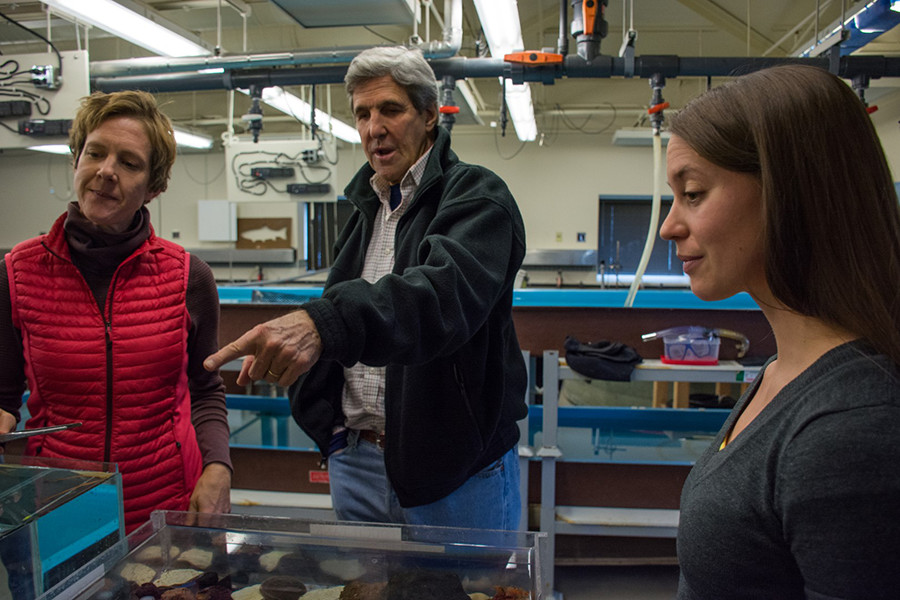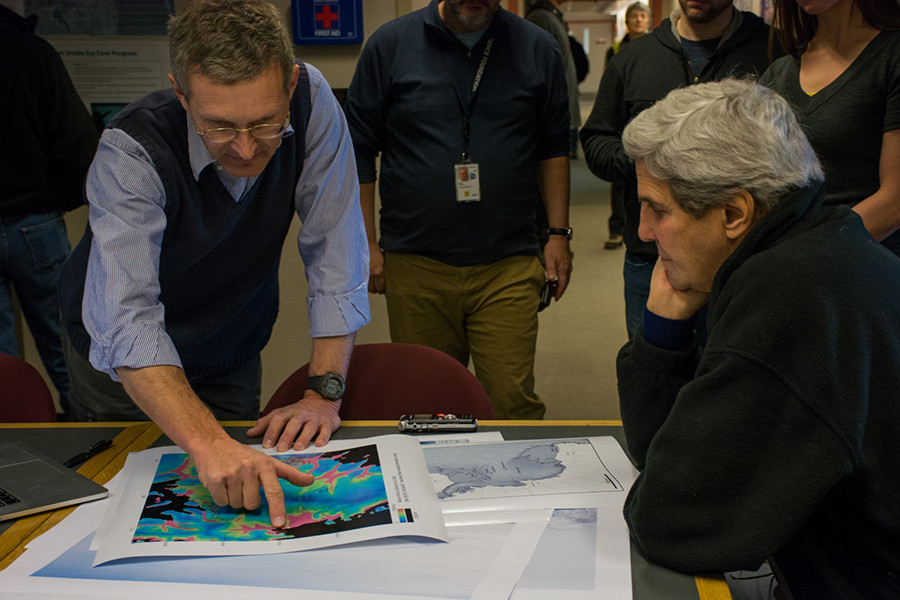
Photo Credit: Mike Lucibella
|
Scientist Amy Moran of the University of Hawai'i at Mänoa (left) tells Secretary of State John Kerry about her research into the effects of warming
oceans on marine organisms as Crary Laboratory Supervisor Beverly Walker (right) looks on.
|
Secretary of State John Kerry Travels to Antarctica
Kerry met with scientists and visited the edge of the new Ross Sea Region Marine Protected Area
By Michael Lucibella, Antarctic Sun Editor
Posted November 15, 2016
Secretary of State John Kerry visited McMurdo Station on November 11, becoming the first Secretary of state to travel to Antarctica, and the most senior U.S. government official to do so.

Photo Credit: Mike Lucibella
Onboard an LC-130 parked at McMurdo Station’s Williams Field, Secretary of State John Kerry speaks with Kelly Falkner, the director of the National Science Foundation’s Division of Polar Programs.
The purpose of the trip was for Kerry to meet with polar researchers studying a wide range of topics supported by the National Science Foundation (NSF), many of which related to the global implications of climate change.
“I particularly wanted to come down here because I was in the Arctic recently and the scientists there kept saying to me… ‘You got to go to Antarctica, you got to get a sense of what is really at risk here, you have to understand the science and what is happening there,’” Secretary Kerry said.
The NSF manages the U.S. Antarctic Program, through which it makes awards to researchers across the nation and provides the logistical infrastructure to support U.S. scientific research on the southernmost continent.
Shortly after the Secretary landed at McMurdo Station, he boarded a helicopter for a tour of the science conducted in the nearby regions. It included a stop at the Cape Royds Adelie penguin colony on Ross Island, an air tour through the Wright and Taylor valleys of the McMurdo Dry Valleys, followed by a final stop at New Harbor.

Photo Credit: Mike Lucibella
Glaciologist John Stone of University of Washington shows maps of the melting West Antarctic Ice Sheet to Secretary of State John Kerry.
The penguin colony abuts the recently-established Ross Sea Region Marine Protected Area. At 580,000 square miles, more than twice the size of Texas, it is the largest area of protected ocean on the planet. The protected area was established in October by a unanimous decision from the 24 nations that make up the Commission for the Conservation of Antarctic Marine Living Resources.
Later in the evening, Kerry addressed the McMurdo community, commending researchers and support staff for their work.
“Thank you all for doing what you do,” Secretary Kerry said. “Hats off to all of you; those of you that spend time out on the ice, in the mountains, in the hills, doing the research that you’re doing, and helping to keep McMurdo as the centerpiece of Antarctic research.”
He spoke about the importance of science, protecting the environment and the important role that international cooperation plays in in both. Afterwards, he answered questions from station residents about the future of the Antarctic.

Photo Credit: Mike Lucibella
At his public address, Secretary of State John Kerry thanked the residents of McMurdo Station for their support of science and spoke about the important role it plays in understanding the world.
The excursion to Antarctica is part of a larger global tour, which included stops in New Zealand, Oman, the United Arab Emirates, Morocco and Peru. While in Morocco, he will participate in the 22nd Conference of the Parties (COP22) to the United Nations Framework Convention on Climate Change, an issue that many researchers supported by the NSF are studying in Antarctica.
The next morning, before boarding a U.S. Air Force C-17 to return to New Zealand, he toured the station’s Crary Science and Engineering Center. There, he met scientists working on topics ranging from ice-core sampling to the health of the marine ecosystem.
Glaciologist John Stone of the University of Washington is studying the history of how glaciers and ice sheets thin and collapse in the Ross Sea region and along the coast of West Antarctica in order to understand how a warming climate might affect them today.
Kerry also spoke to Amy Moran, a marine biologist from the University of Hawai´i at M?noa, who is studying the effects of warming ocean waters on marine animals that live in the Ross Sea, as well as to Jenifer Burns of the University of Alaska, Anchorage, who is studying the life cycle of Weddell seals, the southernmost ranging mammal on Earth.
The trip had originally included a planned visit to Amundsen-Scott South Pole station, but that had to be canceled due to inclement weather.








